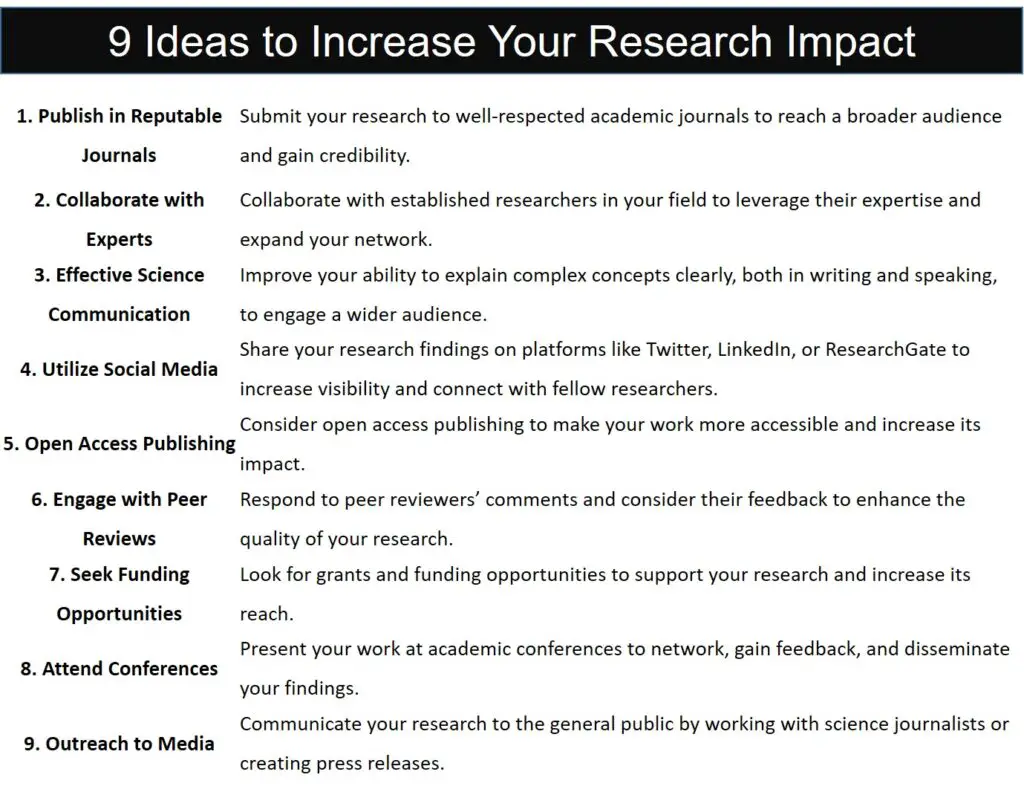Making a meaningful impact in the field of research requires sharing your findings with a larger audience.
While it’s important to write in scholarly journals, it’s just as important to reach out to a wider audience and publish beyond the confines of your field.
We will examine useful strategies in this post to assist you in expanding the audience for your research and increasing its visibility.
What is true impact?
Impact involves creating a significant effect, typically to bring about change. Achieving a true impact necessitates reaching extensive audiences to inspire ideas in as many minds as possible.
Isolating ourselves in a confined space results in disseminating potentially transformative information within a limited echo chamber, reaching only a fraction of individuals with valuable insights.
9 Strategies to Reach Wider Audience in Research

1. Extend your title
Make sure your article’s title is clear and devoid of any jargon that excludes people. In order to draw in specialists from other fields who might have only a passing interest in your subject matter, you want to give the reader a taste of what’s to come. To do this, maintain simplicity.
It is common practice to simply state your key findings in the title, making sure to keep it high enough to draw the interest of a wide audience. It’s more usual for people to desire to know why than what.
For example, a new finding on the operation of a specific solar power feature is interesting, but why is it fascinating?
Could it reduce emissions?
Make it clear and simple.
2. Craft a Clear introduction
In order to attract a wider audience, your research should tell a compelling story.
Begin with a clear and engaging introduction that emphasizes the significance of your work in a broader context. Use straightforward language to explain complex concepts and provide real-world examples, making your research more relatable.
3. Use Platforms for Online Education
Provide educational resources on websites like Coursera, edX, or YouTube that are relevant to your research.
Developing video lectures or online courses can help you become an authority in your subject and teach a worldwide audience.
4. Make Use of Social Media
Social media sites are excellent resources for broadening the audience for your research. Make professional profiles on social media sites such as LinkedIn and Twitter, and post your publications, insights, and research results on a regular basis.
Participate in pertinent topics and answer comments to establish a relationship with your followers.
5. Work Together with Other Researchers
Working together is essential to reaching more people. Collaborate with researchers from various fields or establishments to incorporate many different perspectives into your research. Collaborative publications and projects can help you reach a wider audience and leverage each other’s networks.
6. Launch a Website or Blog:
To present your knowledge in a more readable style, think about launching a personal website or blog. Compose blog posts outlining your findings, answering frequently asked questions about your area of expertise, and going over how your study will be used in the real world. By doing this, you expand your audience and position yourself as an expert in your field of study.
7. Participate in Science Communication
Science communication entails converting difficult findings into content that the general public can understand. To assist in creating interesting content that effectively communicates your findings, such podcasts, infographics, and films, think about attending science communication workshops or hiring a science communicator.
8. Gain Media Coverage
Speak with reporters or other media that covers subjects linked to your research. An interview or news story that is strategically placed can greatly raise awareness of your work. Prepare a short and interesting pitch to get their attention.
9. Organize and Participate in Public Events:
Take part in seminars, conferences, and public lectures to convey your findings to an audience live. To bridge the gap between academia and the general public, think about planning outreach events, like science fairs or community presentations, to engage with nearby communities and schools.
10. Open Access Publishing
Think about submitting your research to repositories or journals with open access. Publications that are open access eliminate access restrictions and make it possible for a larger audience to read and cite your work.
Conclusion
Reaching beyond the academic community with your research is a worthwhile attempt that can result in more impact and recognition.
You can effectively reach a bigger and more diverse audience by creating a captivating story, using social media, working with others, participating in science communication, and investigating different channels for sharing your work.
Keep in mind that the objective is to change the world by disseminating information and perspectives that can assist society as a whole, not just your research.



